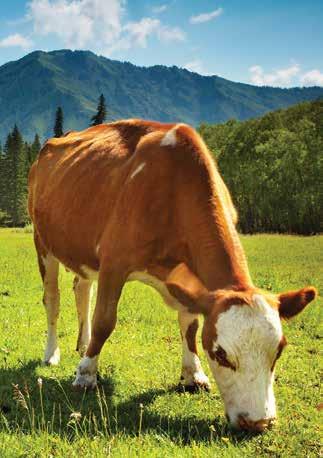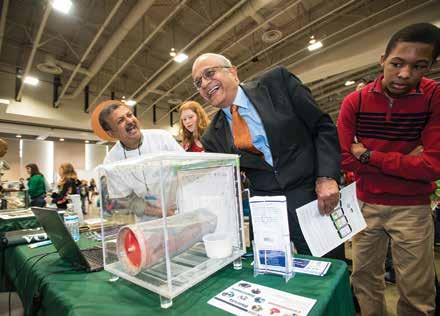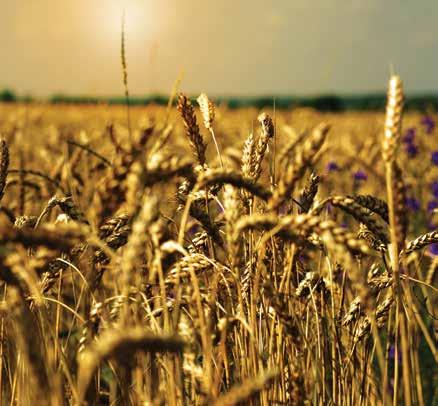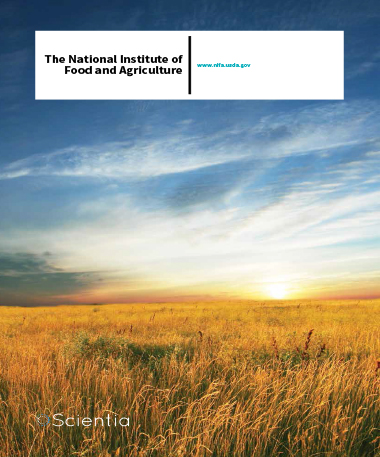The U.S. Department Of Agriculture’s National Institute Of Food And Agriculture
An exclusive interview with Dr Sonny Ramaswamy, the director of the National Institute of Food and Agriculture (NIFA)

As one of 18 agencies within the United States Department of Agriculture (USDA), the National Institute of Food and Agriculture (NIFA) is the extramural science agency. NIFA provides funding through grants to catalyse transformative discoveries, education, and engagement to solve societal agricultural challenges. The agency’s mandate is to address nutritional security, in the context of the diminishing land and water resources, climate change, extreme weather events and droughts, and environmental degradation, and ensure the well-being of families and communities.
NIFA partners with America’s Land-Grant University (LGU) System of major public universities, which have a presence in every U.S. state, county (district), and territory. The LGUs, which have the tripartite mission of research, extension, and teaching, include also historically black colleges, tribal colleges, Hispanic-serving institutions, and Alaska Native-Serving and Native Hawaiian-Serving Institutions.
NIFA’s unique quality is that its investments, which result in cutting-edge discoveries, are translated into innovations and solutions by applied research and extension personnel and delivered to the end users to put knowledge into practice. Here, we speak to Dr Sonny Ramaswamy, the director of NIFA, who tells us all about the organisation, and its activities in working towards a future of sustainable agriculture.
You have had a very varied and successful career in the agricultural sciences, including undertaking research that was NIFA funded. What motivated you to pursue a career within the organisation?
I have been in academia all my life – it’s as though I never left college – and have been a successful scientist, educator, and administrator at several Land-Grant Universities in the United States. I became the dean of the College of Agricultural Sciences at Oregon State University in 2009 during the depth of the global economic recession, and the budget situation was incredibly difficult. We were able to work with the stakeholders, legislators, and donors to successfully mitigate the impact of the intense budget cuts and continued to ensure the college offered the best education to students and undertook the best research and extension in support of the varied and vibrant agricultural and food scene in Oregon.
We had just started to make significant progress when, out of the blue, I received a telephone call on the 8th of August 2011, which changed my life: the caller informed me of President Barack Obama’s intent to appoint me as the director of the National Institute of Food and Agriculture. I remember I was driving that day to the airport in Portland, Oregon for a fundraising trip to the US Midwest; my knees started shaking and I needed to pull over to complete the conversation. I was stoked and shared the news with my wife and daughter; there was no doubt that I would step up to accept the appointment – how could anyone, particularly an immigrant, refuse to serve one’s nation!
With much regret we left Oregon State University, an excellent institution, and Oregon, one of the most beautiful places in America.
Following nine months of an intense security clearance process, on 7 May 2012, I was sworn in to office by US Department of Agriculture Secretary Tom Vilsack. This was not a position I sought; however, I have had significant success and have enjoyed serving as director of NIFA.
What is NIFA’s annual research budget and what types of grants are available from NIFA?
For fiscal year 2016 (Oct. 1, 2015 – Sept. 30, 2016), NIFA has a total budget of nearly US $1.5 billion. NIFA supports research, education, and extension efforts primarily through two types of funding opportunities known as Capacity Grants and Competitive Grants. Capacity Grants ensure that the Land-Grant University (LGU) System and other partners maintain the ‘capacity’ to conduct research and extension activities. The amount of funds provided to each institution is determined by a statutorily defined formula that may include variables such as the rural population, farm population, number of farms, forest acreage, and poverty rates.
NIFA awards Competitive Grants for fundamental and applied research, extension, and higher education activities, as well as for projects that integrate research, education, and extension functions. America’s flagship competitive grants program, the Agriculture and Food Research Initiative (AFRI), will provide $350 million in Fiscal Year 2016. Competitive programs enable NIFA to attract a large pool of applicants to work on agricultural issues of national interest, and to select the highest quality proposals submitted by eligible individuals, institutions, or organisations. Awards are made following a rigorous peer-review process. Individuals, institutions, or organisations may apply according to criteria listed in each Request for Application.
Typically, eligibility for the Capacity Programs funding is restricted to the Land-Grant Universities or other specified institutions. Competitive program eligibility is broader, and may include Land-Grant and non-Land-Grant public academic and private academic institutions, government agencies, non-governmental organisations, the private sector, community based organisations, and individuals. US-based grantees may partner with international collaborators.

Please tell our readers a bit about the ways in which NIFA works to sustain natural resources and the environment. On this same thread, explain the means by which NIFA is working to mitigate the impacts of climate change?
One of the Farm Bill priorities is Bioenergy, Natural Resources, and Environment, which provides NIFA the mandate to invest in natural resources and the environment, including climate change and water. NIFA takes a holistic approach to maximising food production that is environmentally, economically, and socially sustainable. We recognise that there is no ‘one-size-fits-all’ solution and consider a diversity of needs for different crops, livestock, and the communities that farm and consume them.
For example, through the AFRI program, NIFA funds several Coordinated Agricultural Projects (CAPs). Research teams funded by CAPs use research, education, and extension approaches to study and implement agricultural practices that sustain natural resources and the environment and work to mitigate the impacts of climate change. CAPs are large-scale, multi-million dollar projects to promote collaboration, open communication, and the exchange of information while reducing duplication of effort and increasing coordination among individuals, institutions, states, and regions. One good example of one of NIFA’s currently-funded CAPs is the Regional Approaches to Climate Change (REACCH) project, led by the University of Idaho, which aims to enhance sustainability of Pacific Northwest Agriculture (PNW) cereal systems and contribute to climate change mitigation. REACCH implements sustainable practices for cereal production, reduces greenhouse gas emissions from agriculture, collaborates with stakeholders and policy makers, and prepares professionals to address climate change in agriculture. Another interesting project led by Washington State University, called the Northwest Advanced Renewables Alliance, is developing the chemistry and infrastructure for converting forest residuals (twigs and small limbs leftover after timber harvest in slash piles) into bio-jet fuel. An Alaska Airlines demonstration flight using fuel developed by NARA and partners is planned by 2017.
NIFA also funds a number of additional projects on adapting agriculture to drought, flooding, and water conservation. One example is the AFRI Climate Variability and Change Challenge Area, which supports research on beef cattle selection and management for adaptation to drought.
How does NIFA facilitate international collaboration?
NIFA participates in several international collaborations to mitigate and prevent the spread of crop and livestock disease, including the United Kingdom’s Biotechnology and Biological Sciences Research Council (BBSRC), the US-Israel Binational Agricultural Research and Development (BARD) program, and with the Republic of Ireland Department of Agriculture, Food, and the Marine (DAFM) and the Northern Ireland Department of Agriculture and Rural Development (DARD). In 2014, NIFA and BBSRC collaborated in a pilot program to receive and review US-UK collaborative proposals in animal health. The program resulted in five jointly funded research awards totalling more than $2.3 million from NIFA and $3.5 million from BBSRC. Additionally, the Ecology and Evolution of Infectious Diseases Program , a partnership between the US National Science Foundation, the National Institute of Health, NIFA, and BBSRC annually funds projects that address crop and farm animal disease ecology. Finally, the International Wheat Yield Partnership is a group of funders that collaborate to invest in projects aimed at increasing the primary yield of wheat.
‘I received a telephone call on the 8th of August 2011, which changed my life: the caller informed me of President Barack Obama’s intent to appoint me as the director of the National Institute of Food and Agriculture’

How does NIFA approach the challenge of managing trade-offs between maintaining forestry and generating farmland to meet ever-increasing food demands?
The trade-off between producing food and having forests and their products and services is not the real question here. The big picture question is: How do we as a nation – as well as a global community – allocate a finite resource – land – to the various uses that society relies on, such as for the production of food and wood fibre, carbon sequestration, biodiversity, and for housing and commercial development.
NIFA’s approach to meeting the food requirements of the ever increasing human population is from the perspective of facilitating research on enhanced productivity of crops and livestock, increasing water, nitrogen, and phosphorus use efficiency, enhancing drought tolerance and pest resistance, and last, but not least, promoting sustainable consumption and mitigating food waste and food loss. As a result, our expectation is that we will not need to bring in additional land into use for production purposes and can, indeed, also mitigate destruction of forests.
What our nation needs is a vision, supported by policies and economic incentives, that promotes making wise decisions about how we use the land for all of its necessary uses. NIFA’s work is not about making decisions about how land resources are allocated – our work is to advance the science, which includes research, extension, and higher education, by supporting our university partners as they seek to expand the knowledge and practice of efficiently growing healthy food on the agricultural lands we have and to do so in ways that provide food for consumption, income for farmers and ranchers, and economic resiliency for rural communities, while supporting the science of sustaining healthy and productive forests on the land base that is available for forests.
NIFA has supported a $20 million project, PINEMAP, to study loblolly pine across its entire range in the southern U.S. and determine how this important forest can continue to be productive in the face of a changing climate. This work has involved studying how various genetic strains of loblolly pine react to changes in precipitation, one of the primary climate change impacts in the southeastern US, while at the same time being more productive with regard to wood products. Further, the new knowledge is being transferred to forest landowners who will make decisions on what loblolly seedlings to plant based on their genetics and how to manage loblolly pine forests to adapt to and mitigate the changing climate.

Please tell us about some interesting and imaginative projects that NIFA is involved with in working towards a future of sustainable food.
The bulk of NIFA’s investments support traditional crop and livestock agriculture, nutrition, food safety, forestry, and aquaculture. NIFA also funds some ‘out of the box’ disruptive projects that work toward a future of sustainable, environmentally friendly food sources, including the development and deployment of smart systems, sensors, drones, imaging systems, and robots. These projects, in combination with knowledge derived from investments in molecular biology, phenomics and phenotyping, and big data, will promote food production with significantly reduced ecological footprint, while ensuring profitability and economic well-being.
For example, NIFA has invested in the development of robotics that facilitate precision agriculture and aid the harvesting process. One such project involved a team of several institutions led by Carnegie Mellon University and which created a camera-equipped vehicle with the ability to detect fruit and conduct an automated image analysis. The image data is converted into measurements of yield components, such as fruit count, size, and quality. In another related project, researchers at UC Davis developed ‘co-bots’ that are inexpensive, relatively small, and aid humans with the harvesting of fragile crops by supplying them with empty containers and by transporting containers filled with harvested crops to unloading stations. These robots reduce harvesting time by transporting hand-picked crops. The robots also protect worker health by reducing slipping accidents. The prototype navigates in furrows and regulates its speed to reduce vibration.
NIFA serves as a vital contributor to science policy decision-making in the US. Please tell us about some of your success stories to date in this regard.
NIFA funds several projects that influence policy decision-making in the United States. For example, the Environmental Protection Agency used results from the Center for Agricultural and Rural Development’s (CARD) biofuel model in deciding to temporarily waive the conventional biofuel mandate because of the 2012-2013 drought. The mandate typically requires a certain portion of the American motor fuel supply to include biobased ethanol. Drought conditions, however, caused corn production to decline and prices to increase. Therefore, without a waiving the mandate to produce corn-based ethanol, corn prices would rise even more dramatically, resulting in increased prices of animal feed and potentially hurting consumers. CARD’s biofuel model helped show that concerns over the potential negative impacts of temporarily waiving the mandate were not warranted. The team also presented a summary of the water quality effects of corn-based biofuels relative to cellulosic feedstocks to the Roundtable on Environmental Health, a biannual policy conference supported by the National Institute of Health and attended by senior staff from major leading federal agencies and policy advocates in Washington D.C.
Similarly, the National Agricultural and Rural Development Policy Center (NARDeP) provides timely and cutting-edge research on current and emerging public policy priorities and regulations in a quantitative format. This initiative creates and disseminates new datasets from secondary and other sources to policymakers and other interested individuals, serves as a clearinghouse for technology diffusion and educational resources and to disseminate impartial information through web-based training and other publications, and helps to train the next generation of policy analysts. One NARDeP case study investigated which kinds of policies are best for stemming the outmigration of farm labour, given the unrelenting pressure to also continually develop productivity by increasing forms of technology which inherently are laboursaving. This was in response to recent USDA Economic Research Service data, which shows that labour use in agriculture declined by 78 percent between 1948 and 2011, even as agricultural output more than doubled, increasing by nearly 250 percent. This study found that investments in Cooperative Extension have been remarkably effective in keeping farmers in agriculture, over the years 1984–2010. In fact, the authors estimate that 137,700 farmers stayed in farming over this period, who would otherwise have exited had they not benefited from the extension and associated research programs. The study showed that extension spending was directly associated with higher net farm income, which in turn allowed the farmers to continue farming. One of the policy implications of these finding was that public investments in farmers are better made through the research and educational programs of the LGU system, rather than through direct subsidies to farmers, if the policy goal is to keep farmers on the farm.
Additionally, NIFA appears to play a huge role in public outreach and education, please tell us a bit about your activities.
NIFA is one of several US government agencies participating in the Federal Science, Technology, Engineering, and Mathematics (STEM) Education 5-year strategic plan to improve STEM education across America. NIFA and other USDA agencies are partnering with the National Science Foundation and Smithsonian Institution to improve graduate fellowships and providing resources and materials for engaging learners with science. NIFA is also able to leverage its partnership with the LGUs, the Cooperative Extension System, and its regional networks and laboratories. We are also able to reach a very diverse set of stakeholders through our numerous types of LGUs located in both rural and urban communities. Through targeted funding programs to reach out to minority and underserved populations, we support institutions that include Historically Black Colleges and Universities (HBCU), Hispanic- Serving Institutions (HSI), Alaska Native- Serving Institutions, Native Hawaiian-Serving Institutions, Insular areas institutions, and Tribal Colleges and Universities.
NIFA is committed to training the next generation of agricultural scientists. Agriculture is a STEM enterprise, and it is critical to attract more youth from an early age and equip them with the STEM skills required for developing the technologies that will address the emerging issues in agriculture and protecting quality of life. This is a global challenge. In addition to the training opportunities offered through the AFRI ELI and the education component of the CAP grants, NIFA has several other programs that offer educational opportunities, including the Multicultural Scholars Program, the Women and Minorities in Science, Technology, Engineering, and Mathematics Fields (WAMS) Grants Program, Community Food Projects, the Expanded Food and Nutrition Education Program (EFNEP) and the Beginning Farmer and Rancher Development Program.
Finally, the Cooperative Extension System ensures that the science NIFA funds is not solely for the sake of science, but rather is translated into innovations and solutions and delivered to the end-user. Extension provides a clear path of bringing research to the people and gives NIFA a presence in every one of the 3,143 counties, boroughs, and parishes in America, both rural and urban, rich and poor.

Finally, what do you see as being the biggest global challenge that NIFA will face in the next 20 years?
The biggest global challenge that NIFA will face in the next 20 years is to ensure nutritional security, environmental security, and economic security of the burgeoning population, projected to reach almost 450 million in the United States and over 9 billion globally by the year 2050.


